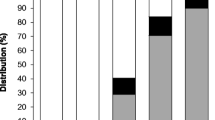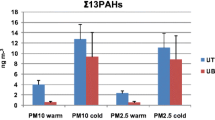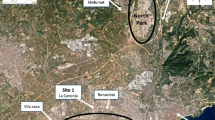Abstract
Polycyclic aromatic hydrocarbons (PAHs) associated with the inhalable fraction of particulate matter were determined for 1 year (2009–2010) at a school site located in proximity of industrial and heavy traffic roads in Delhi, India. PM10 (aerodynamic diameter ≤10 μm) levels were ∼11.6 times the World Health Organization standard. Vehicular (59.5 %) and coal combustion (40.5 %) sources accounted for the high levels of PAHs (range 38.1–217.3 ng m−3) with four- and five-ring PAHs having ∼80 % contribution. Total PAHs were dominated by carcinogenic species (∼75 %) and B[a]P equivalent concentrations indicated highest exposure risks during winter. Extremely high daily inhalation exposure of PAHs was observed during winter (439.43 ng day−1) followed by monsoon (232.59 ng day−1) and summer (171.08 ng day−1). Daily inhalation exposure of PAHs to school children during a day exhibited the trend school hours > commuting to school > resting period in all the seasons. Vehicular source contributions to daily PAH levels were significantly correlated (r = 0.94, p < 0.001) with the daily inhalation exposure level of school children. A conservative estimate of ∼11 excess cancer cases in children during childhood due to inhalation exposure of PAHs has been made for Delhi.






Similar content being viewed by others

References
Akyüz M, Çabuk H (2009) Meteorological variations of PM2.5/PM10 concentrations and particle-associated polycyclic aromatic hydrocarbons in the atmospheric environment of Zonguldak, Turkey. J Hazard Mater 170:13–21
Anderson LM, Diwan BA, Fear NT, Roman E (2000) Critical windows of exposure for children’s health: cancer in human epidemiological studies and neoplasms in experimental animal models. Environ Health Perspect 108:573–594
American Thoracic Society (1996) Health effects of outdoor air pollution. Part 2. Committee of the Environmental and Occupational Health Assembly of the American Thoracic Society. Am J Respir Crit Care Med 153:477–498
Baxter LK, Clougherty JE, Laden F, Levy JI (2007) Predictors of concentrations of nitrogen dioxide, particulate matter, and particle constituents inside of lower socioeconomic status urban homes. J Expo Sci Environ Epidemiol 17:433–444
Beckerman B, Jerrett M, Brook JR, Verma DK, Arain MA, Finkelstein MM (2008) Correlation of nitrogen dioxide with other traffic pollutants near a major expressway. Atmos Environ 42:275–290
Bonn PJA, Driscoll K (1996) Particles, inflammation and respiratory tract carcinogenesis. Toxicol Lett 88:109–113
Caricchia AM, Chiavarini S, Pezza M (1999) Polycyclic aromatic hydrocarbons in the urban atmospheric particulate matter in the city of Naples (Italy). Atmos Environ 33:3731–3738
Census of India (2011) Government of India, Office of the Registrar General and Census Commissioner, New Delhi
Chen SC, Liao CM (2006) Health risk assessment on human exposed to environmental polycyclic aromatic hydrocarbons pollution sources. Sci Total Environ 366:112–123
Chithra VS, Shiva Nagendra SM (2012) Indoor air quality investigations in a naturally ventilated school building located close to an urban roadway in Chennai, India. Build Environ 54:159–167
Dejmek J, Solansky I, Beneš I, Leníček J, Šrám RJ (2000) The impact of polycyclic aromatic hydrocarbons and fine particles on pregnancy outcome. Environ Health Perspect 108:1159–1164
Delgado-Saborit JM, Aquilina N, Baker S, Harrad S, Meddings C, Harrison RM (2010) Determination of atmospheric particulate-phase polycyclic aromatic hydrocarbons from low volume air samples. Anal Methods 2:231–242
Delhi Govt. (2012) http://delhi.gov.in/wps/wcm/connect/fac089804f846492b2e0b2132654ee81/59+−+79+Transport+.pdf?MOD=AJPERES
DeMarini D, Brooks L, Warren S, Kobayashi T, Gilmour M, Singh P (2004) Bioassay-directed fractionation and salmonella mutagenicity of automobile and forklift diesel exhaust particles. Environ Health Perspect 112:814–819
Dickhut RM, Canuel EA, Gustafson KE, Liu K, Arzayus KM, Walker SE, Edgecombe G, Gaylor MO, MacDonald EH (2000) Automotive sources of carcinogenic polycyclic aromatic hydrocarbons associated with particulate matter in Chesapeake Bay region. Environ Sci Technol 34:4635–4640
Dockery DW, Skerrett PJ, Walters D, Gilliland F (2005) Development of lung function. In: Effects of air pollution on children’s health and development: a review of the evidence. World Health Organization special programme on health and environment. European Centre for Environment and Health, Bonn, pp 108–133
Durant J, Busby W, Lafleur A, Penman B, Crespi C (1996) Human cell mutagenicity of oxygenated, nitrated and unsubstituted polycyclic aromatic hydrocarbons associated with urban aerosols. Mutat Res 371:123–157
Durant J, Lafleur A, Busby W, Donhoffner L, Penman B, Crespi C (1999) Mutagenicity of C24H14 PAH in human cells expressing CYP1A1. Mutat Res Genet Toxicol Environ Mutagen 446:1–14
Finlayson-Pitts BJ, Pitts JN Jr (2000) Chemistry of upper and lower atmosphere: theory, experiments and applications. Academic, San Diego
Foster A, Kumar N (2011) Health effects of air quality regulations in Delhi, India. Atmos Environ 45:1675–1683
Ganguly D, Jayaraman A, Rajesh TA, Gadhavi H (2006) Wintertime aerosol properties during foggy and non-foggy days over urban center Delhi and their implications for shortwave radiative forcing. J Geophys Res 111, D15217
Goyal R, Khare M (2011) Indoor air quality modelling for PM10, PM2.5, and PM1.0 in naturally ventilated classrooms of an urban Indian school building. Environ Monit Assess 176:501–516
Guo H, Lee SC, Ho KF, Wang XM, Zou SC (2003) Particle-associated polycyclic aromatic hydrocarbons in urban air of Hong Kong. Atmos Environ 37:5307–5317
Gurjar BR, Jain A, Sharma A, Agarwal A, Gupta P, Nagpure AS, Lelieveld J (2010) Human health risks in megacities due to air pollution. Atmos Environ 44:4606–4613
Hoek G, Pattenden S, Willers S, Antova T, Fabianova E, Braun-Fahrländer C, Forastiere F, Gehring U, Luttmann-Gibson H, Grize L, Heinrich J, Houthuijs D, Janssen N, Katsnelson B, Kosheleva A, Moshammer H, Neuberger M, Privalova L, Rudnai P, Speizer F, Slachtova H, Tomaskova H, Zlotkowska R, Fletcher T (2012) PM10 and children's respiratory symptoms and lung function in the PATY study. Eur Respir J 40:538–547
Hu B, Freihaut J, Bahnfleth W, Aumpansub P, Thran B (2007) Modeling the influence of human activity on particle resuspension and dispersion in a multizone indoor environment with HVAC system. J Archit Eng 13:187–193
Jung KH, Yan B, Chillrud SN, Perera FP, Whyatt R, Camann D, Kinney PL, Miller RL (2010) Assessment of benzo(a)pyrene equivalent carcinogenicity and mutagenicity of residential indoor versus outdoor polycyclic aromatic hydrocarbons exposing young children in New York City. Int J Environ Res Public Health 7:1889–1900
Khalili NR, Scheff PA, Holsen TM (1995) PAH source fingerprints for coke ovens, diesel and gasoline engines, highway tunnels, and wood combustion emissions. Atmos Environ 29:533–542
Khillare PS, Sarkar S (2012) Airborne inhalable metals in residential areas of Delhi, India: distribution, source apportionment and health risks. Atmos Pol Res 3:46–54
Koistinen KJ, Hanninen O, Rotko T, Edwards RD, Moschandreas D, Jantunen MJ (2001) Behavioral and environmental determinants of personal exposures to PM2.5 in EXPOLIS—Helsinki, Finland. Atmos Environ 35:2473–2481
Kolokotroni M, Ge YT, Katsoulas D (2002) Monitoring and modelling indoor air quality and ventilation in classrooms within a purpose-designed naturally ventilated school. Indoor Built Environ 11:316–326
Kumar A, Tyagi SK (2006) Benzene and toluene profiles in ambient air of Delhi as determined by active sampling and GC analysis. J Sci Ind Res India 65:252–257
Lanki T, Ahokas A, Alm S, Janssen NAH, Hoek G, De Hartog JJ, Brunekreef B, Pekkanen J (2007) Determinants of personal and indoor PM2.5 and absorbance among elderly subjects with coronary heart disease. J Expo Sci Environ Epidemiol 17:124–133
Larsen RK, Baker JE (2003) Source apportionment of polycyclic aromatic hydrocarbons in the urban atmosphere: a comparison of three methods. Environ Sci Technol 37:1873–1881
Lee RGM, Jones KC (1999) The influence of meteorology and air masses on daily atmospheric PCB and PAH concentrations at a UK location. Environ Sci Technol 33:705–712
Levy JI, Bennett DH, Melly SJ, Spengler JD (2003) Influence of traffic patterns on particulate matter and polycyclic aromatic hydrocarbon concentrations in Roxbury, Massachusetts. J Expo Sci Environ Epidemiol 13:364–371
Li CS, Ro YS (2000) Indoor characteristics of polycyclic aromatic hydrocarbons in the urban atmosphere of Taipei. Atmos Environ 34:611–620
Li J, Zhang G, Li XD, Qi SH, Liu GQ, Peng XZ (2006) Source seasonality of polycyclic aromatic hydrocarbons (PAHs) in a subtropical city, Guangzhou, South China. Sci Total Environ 355:145–155
Lim SS, Vos T, Flaxman AD, Danaei G et al (2012) A comparative risk assessment of burden of disease and injury attributable to 67 risk factors and risk factor clusters in 21 regions, 1990–2010: a systematic analysis for the Global Burden of Disease Study 2010. Lancet 380:2224–2260
Liu Y, Zhu L, Shen X (2001) Polycyclic aromatic hydrocarbons (PAHs) in indoor and outdoor air of Hangzhou, China. Environ Sci Technol 35:840–844
Ludykar D, Westerholm R, Almén J (1999) Cold start emissions at +22, −7 and −20°C ambient temperatures from a three-way catalyst (TWC) car: regulated and unregulated exhaust components. Sci Total Environ 235:65–69
Masih J, Masih A, Kulshrestha A, Singhvi R, Taneja A (2010) Characteristics of polycyclic aromatic hydrocarbons in indoor and outdoor atmosphere in the North central part of India. J Hazard Mater 177:190–198
Masih J, Singhvi R, Kumar K, Jain VK, Taneja A (2012) Seasonal variation and sources of polycyclic aromatic hydrocarbons (PAHs) in indoor and outdoor air in a semi arid tract of Northern India. Aerosol Air Qual Res 12:515–525
Menichini E, Monfredini F, Merli F (1999) The temporal variability of the profile of carcinogenic polycyclic aromatic hydrocarbons in urban air: a study in a medium traffic area in Rome, 1993–1998. Atmos Environ 33:3739–3750
MoEF (2009) Environment (Protection) Seventh Amendment Rules. Ministry of Environment and Forests. Government of India Press, New Delhi
Hernández S, Mugica V, Torres M, García R (2010) Seasonal variation of polycyclic aromatic hydrocarbons exposure levels in Mexico City. J Air Waste Manage Assoc 60:548–555
Naumova YY, Eisenreich SJ, Turpin BJ, Weisel CP, Morandi MT, Colome SD, Totten LA, Stock TH, Winer AM, Alimokhtari S, Kwon J, Shendell D, Jones J, Maberti S, Wall SJ (2002) Polycyclic aromatic hydrocarbons in the indoor and outdoor air of three cities in the U.S. Environ Sci Technol 36:2552–2559
Nielsen T, Jorgensen H, Larsen J, Poulsen M (1996) City air pollution of polycyclic aromatic hydrocarbons and other mutagens: occurrence, sources and health effects. Sci Total Environ 189–190:41–49
Nisbet ICT, LaGoy PK (1992) Toxic equivalency factors (TEFs) for polycyclic aromatic hydrocarbons (PAHs). Regul Toxicol Pharm 16:290–300
Norramit P, Cheevaporn V, Itoh N, Tanaka K (2005) Characterization and carcinogenic risk assessment of polycyclic aromatic hydrocarbons in the respirable fraction of airborne particles in the Bangkok metropolitan area. J Health Sci 51:437–446
Northridge ME, Yankura J, Kinney PL, Santella RM, Shepard P, Riojas Y, Agarwal M, Stickland P (1999) Diesel exhaust exposure among adolescents in Harlem: a community-driven study. Am J Public Health 89:998–1002
Pandey JS, Rakesh K, Devotta S (2005) Health risks of NO2, SPM and SO2 in Delhi (India). Atmos Environ 39:6868–6874
Park JS, Wade TL, Sweet ST (2002) Atmospheric deposition of PAHs, PCBs, and organochlorine pesticides to Corpus Christi Bay, Texas. Atmos Environ 36:1707–1720
Pengchai P, Chantara S, Sopajaree K, Wangkarn S, Tengcharoenkul U, Rayanakorn M (2009) Seasonal variation, risk assessment and source estimation of PM10 and PM10-bound PAHs in the ambient air of Chiang Mai and Lamphun, Thailand. Environ Monit Assess 154:197–218
Perera FP (1997) Environment and cancer: who are susceptible? Science 278:1068–1073
PereraFP RV, Whyatt RM, Tsai WY, Tang D, Diaz D, Hoepner L, Barr D, Tu YH, Camann D, Kinney P (2006) Effect of prenatal exposure to airborne polycyclic aromatic hydrocarbons on neurodevelopment in the first 3 years of life among inner-city children. Environ Health Perspect 114:1287–1292
Planning Department (2008) Economic survey of Delhi 2007–2008. Government of NCT of Delhi, Delhi
Planning Department (2011) Economic survey of Delhi 2010–2011. Government of NCT of Delhi, Delhi
Quiteiro S, Arbilla G, Bauerfeld G, Moreira J (2007) Polycyclic aromatic hydrocarbons and their molecular diagnostic ratios in airborne particles PM10 collected in Rio de Janeiro, Brazil. Water Air Soil Pollut 179:79–92
Rajarathnam U, Seghal M, Nairy S, Patnayak RC, Chhabra SK, Kilnani KV, Ragavan S (2011) Time-series study on air pollution and mortality in Delhi. In: Public health and air pollution in Asia (PAPA): coordinated studies of short-term exposure to air pollution and daily mortality in two Indian cities. Research Report 157. Health Effects Institute, Boston, MA
Rajput N, Lakhani A (2010) Measurements of polycyclic aromatic hydrocarbons in an urban atmosphere of Agra, India. Atmosfera 23:165–183
Reponen T, Grinshpun SA, Trakumas S, Martuzevicius D, Wang ZM, LeMasters G, Lockey JE, Biswas P (2003) Concentration gradient patterns of aerosol particles near interstate highways in the Greater Cincinnati airshed. J Environ Monit 5:557–562
Rickwood P, Knight D (2009) The health impacts of local traffic pollution on primary school age children. State of Australian Cities 2009 conference proceedings
Saarnio K, Sillanpää M, Hillamo R, Sandell E, Pennanen AS, Salonen RO (2008) Polycyclic aromatic hydrocarbons in size-segregated particulate matter from six urban sites in Europe. Atmos Environ 42:9087–9097
Sahu SK, Beig G, Parkhi NS (2011) Emissions inventory of anthropogenic PM2.5 and PM10 in Delhi during commonwealth games 2010. Atmos Environ 45:6180–6190
Sarkar S, Khillare PS, Jyethi DS, Hasan A, Parween M (2010) Chemical speciation of respirable suspended particulate matter during a major firework festival in India. J Hazard Mater 184:321–330
Schwartz J (2004) Air pollution and children's health. Paediatrics 113:1037–1043
Sequeira J (2008) A toxic issue: air pollution in New Delhi. Harv Int Rev 30:3
Shi GL, Feng YC, Wu JH, Li X, Wang YQ, Xue YH, Zhu T (2009) Source identification of polycyclic aromatic hydrocarbons in urban particulate matter of Tangshan, China. Aerosol Air Qual Res 3:309–315
Simcik MF, Eisenreich SJ, Lioy PJ (1999) Source apportionment and source/sink relationship of PAHs in the coastal atmosphere of Chicago and Lake Michigan. Atmos Environ 33:5071–5079
Spira-Cohen A, Chen LC, Kendall M, Sheesley R, Thurston GD (2010) Personal exposures to traffic-related particle pollution among children with asthma in the South Bronx, NY. J Expo Sci Environ Epidemiol 20:446–456
Tan JH, Bi XH, Duan JC, Rahn KA, Sheng GY, Fu JM (2006) Seasonal variation of particulate polycyclic aromatic hydrocarbons associated with PM10 in Guangzhou, China. Atmos Res 80:250–262
Tuntawiroon J, Mahidol C, Navasumrit P, Autrup H, Ruchirawat M (2007) Increased health risk in Bangkok children exposed to polycyclic aromatic hydrocarbons from traffic-related sources. Carcinogenesis 28:816–822
USEPA (U.S. Environmental Protection Agency) (2010) Development of a relative potency factor (RPF) approach for polycyclic aromatic hydrocarbon (PAH) mixtures (external review draft). EPA/635/R-08/012A. USEPA, Washington DC
Wada M, Kido H, Kishikawa N, Tou T, Tanaka M, Tsubokura J, Shironita M, Matsui M, Kuroda N, Nakashima K (2001) Assessment of air pollution in Nagasaki city: determination of polycyclic aromatic hydrocarbons and their nitrated derivatives and some metals. Environ Pollut 115:139–147
Wang X, Cheng H, Xu X, Zhuang G, Zhao C (2008) A wintertime study of polycyclic aromatic hydrocarbons in PM2.5 and PM2.5–10 in Beijing: assessment of energy structure conversion. J Hazard Mater 157:47–56
World Health Organization (2000) Air Quality Guidelines for Europe, 2nd ed., WHO, Regional Office for Europe, Copenhagen
Xue WL, Warshawsky D (2005) Metabolic activation of polycyclic and heterocyclic aromatic hydrocarbons and DNA damage: a review. Toxicol Appl Pharmacol 206:73–93
Yassaa N, Meklati BY, Cecinato A, Marino F (2001) Particulate n-alkanes, n-alkanoic acids and polycyclic aromatic hydrocarbons in the atmosphere of Algiers City Area. Atmos Environ 35:843–1851
Yunker MB, MacDonald RW, Vingarzan R, Mitchell RH, Goyette D, Sylvestre S (2002) PAHs in the Fraser River basin: a critical appraisal of PAH ratios as indicators of PAH source and composition. Org Geochem 33:489–515
Zeiger E (2001) Mutagens that are not carcinogens: faulty theory or faulty tests? Mutat Res Genet Toxicol Environ Mutagen 492:29–38
Zhang Y, Tao S (2009) Global atmospheric emission inventory of polycyclic aromatic hydrocarbons (PAHs) for 2004. Atmos Environ 43:812–819
Zhou B, Zhao B (2012) Population inhalation exposure to polycyclic aromatic hydrocarbons and associated lung cancer risk in Beijing region: contributions of indoor and outdoor sources and exposure. Atmos Environ 62:472–480
Zhou Y, Levy JI (2007) Factors influencing the spatial extent of mobile source air pollution impacts: a meta-analysis. BMC Publ Health 7:89
Acknowledgments
Fellowship awarded by Indian Council of Medical Research (ICMR) to DSJ is duly acknowledged. The permission given by Kulachi Hansraj Model School, New Delhi to use the school building for operating the air sampler is acknowledged. The authors are thankful to the anonymous reviewers for their constructive comments and suggestions.
Author information
Authors and Affiliations
Corresponding author
Additional information
Responsible editor: Gerhard Lammel
Rights and permissions
About this article
Cite this article
Jyethi, D.S., Khillare, P.S. & Sarkar, S. Risk assessment of inhalation exposure to polycyclic aromatic hydrocarbons in school children. Environ Sci Pollut Res 21, 366–378 (2014). https://doi.org/10.1007/s11356-013-1912-6
Received:
Accepted:
Published:
Issue Date:
DOI: https://doi.org/10.1007/s11356-013-1912-6



